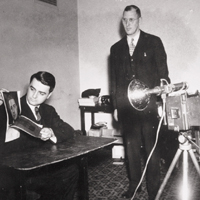On Friday, February 21, 1947, at a meeting of the Optical Society of America in New York City, Edwin Land introduced the one-step photography process. "Land's introduction of the concept of instant photography was not a traditional commercial product unveiling. It was something new and unexpected, and could well have been stifled or ignored by a jaded trade press corps, used to handouts from established giant firms," Land biographer Victor McElheny argues. "Instead, instant photography was unveiled at a scientific conference as a technical breakthrough—to an audience of science reporters."61
In a theatrical demonstration—the pacing and dramatic effect of which had been well-rehearsed—the soon-to-be-famous inventor, then 37 years old, sat for his portrait in front of a large motorized view camera. With a turn of a knob, Land pulled out and detached the negative-positive sandwich from the camera. After one minute, he peeled away an 8-by-10-inch print from the negative. A sequence of photographs captured the tense moments as Land posed for his portrait, followed by his visible relief when the first public demonstration of instant photography proved successful.
Newspapers featuring the shot of Land with his self-portrait heralded the new photographic process around the country: "Single Step Completes All Processing While Photographer Remains at the Scene"; "Camera with One-Minute Print Heralds New Photography Era"; and "Snap Shutter, Wait One Minute—Presto! Camera Turns Out Finished Photo."62 Taking after the original 1888 Kodak slogan "You press the button, we do the rest," a New York Times headline simply stated: "The Camera Does the Rest."63 Life magazine featured the dramatic image of Land with his instantly made portrait as its "Picture of the Week."64 "In an electric instant Land had reinvented photography, his company, and himself. Never was a birth so vividly recorded," writes Peter C. Wensberg, who later became Polaroid's senior vice president for marketing.65
At this juncture, Polaroid Corporation still had to ensure the availability of large quantities of film for its promising commercial release of instant photography the following year. Polaroid outsourced the manufacture of the negative to Kodak, but would keep the production of the positive in-house. In the ensuing months, Polaroid's legal team continued to apply for patents for Land's one-step system, while the SX-70 group made the final push to complete the design of a camera that would make the complex process of one-step photography possible and the act of taking the picture amazingly simple.
- 60. Ibid.
- 61. McElheny, interview by Banta, August 8, 2016.
- 62. Polaroid Corporation Administrative Records, Box I.90 and Box I.91, Baker Library, Harvard Business School.
- 63. "The Camera Does the Rest," New York Times, February 22, 1947, 28.
- 64. "Picture of the Week," Life 22, no. 9 (March 3, 1947): 32-33.
- 65. Peter C. Wensberg, Land's Polaroid: A Company and the Man Who Invented It (Boston: Houghton Mifflin Company, 1987), 16.





